ioc初步理解(二) 简单实用autofac搭建mvc三层+automapper=》ioc(codeFirst)
之前在园子闲逛的时候,发现许多关于automapper的文章,以及用aotufac+automapper合在一起用。当然发现大多数文章是将automapper的特点说出或将automapper几处关键代码放出。当然有过基础的人看这种文章没有什么问题,但是对于完全没有基础的小白来看完全是灾难级别的(我就是),经常按着博文一点一点的写,突然发现少了一部分导致代码无法运行。在搜索各种文章之后,终于用自己的理解写出了一个简单的运用automapper的demo,日后待我对automapper理解加深会进一步更新。【此文章希望对想能初步运用automapper的小白写出。当然也希望各位大牛提出意见】(关于autofac详细讲解)
0】首先看看automapper的介绍吧:
automapper是对象到对象的映射工具。在完成映射规则之后,automapper可以将源对象转换为目标对象。
1】首先放出项目结构图
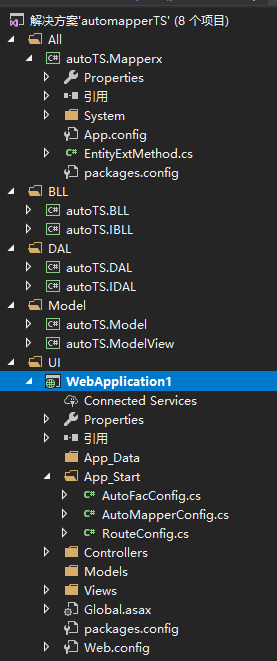
由于此demo运用的是mvc三层+autofac实现依赖注入,所以文件中有三层以及ui层app_Start下的autoFacConfig.cs文件。之前有一篇博文详细讲解了autofac,所以这里只是简单介绍一下代码。主要目光放在mode层和automapper相关的文件。
2】首先贴出各层代码
model文件下结构
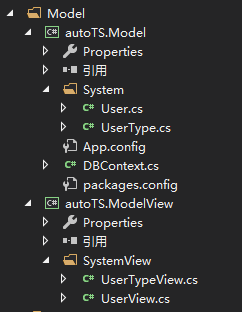
可以看到model文件夹下有两个内库autoTS.Model和autoTS.ModelView(其实autoTS.ModelView下文件可以放到autoTS.Model中,刚刚写的时候忘记了)
autoTS.Mode中system文件夹中文件是和数据库中表一一对应。而autoTS.ModelView下system中文件则是和autoTS.Mode中system文件夹中文件对应(为了实现automapper的功能)将两者进行对比一下


可以看到两者的不同,明显负责连接数据库的model彼modelView多了一些标志(上传csdn中代码的时候忘记写这些,可以下载demo和阅读此博客)
然后autoTs.model层下DBContext.cs代码(autoTS.Model层需要在nuget中引用EntityFramework)
public class DBContext : DbContext
{ public DBContext() : base("name=DatabaseTS") { }//配置文件中连接数据库设置的name
public DbSet<User> User { get; set; } public DbSet<UserType> UserType { get; set; }
}
3】接下来是DAL文件的结构以及代码(不是本文章主要内容值贴出代码,不加以详细说明)
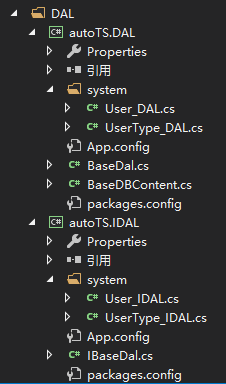
先是idal层中的文件代码(需要nuget中引用EntityFramework 和autoTS.Model)
IBaseDal.cs
//具体业务依赖于接口
public interface IBaseDal<TEntity> where TEntity : class
{
#region 1.0 增 void Add(TEntity model); #endregion #region 2.0 删 void Delete(TEntity model, bool isAddedDbContext); #endregion #region 3.0 改 void Edit(TEntity model, string[] propertyNames); #endregion #region 4.0 查 #region 4.0.1 根据条件查询 List<TEntity> QueryWhere(Expression<Func<TEntity, bool>> where); #endregion
#endregion #region 5.0 统一保存 /// <summary>
/// 统一将EF容器对象中的所有代理类生成相应的sql语句发给db服务器执行
/// </summary>
/// <returns></returns>
int SaveChanges(); #endregion }
system中User_IDAL.cs
public interface User_IDAL : IBaseDal<User>
{
}
然后是dal层中的代码(需要引用EntityFramework 和autoTS.Model、autoTS.IDAL)
BaseDal.cs
public class BaseDal<TEntity> : IBaseDal<TEntity> where TEntity : class
{
//1.0 实例化EF上下文
DbContext db = BaseDBContent.GetCurrentThreadInstance(); //2.0 定义DbSet<T> 对象
public DbSet<TEntity> _dbset; //3.0 在构造函数的初始化_dbset
public BaseDal()
{
_dbset = db.Set<TEntity>();
} #region 1.0 增 public virtual void Add(TEntity model)
{
//1.0 参数合法性验证
if (model == null)
{
throw new Exception("BaseRepository泛型类中,新增操作的实体不能为空");
} //2.0 进行新增操作
_dbset.Add(model);
} #endregion #region 2.0 删 public virtual void Delete(TEntity model, bool isAddedDbContext)
{
//1.0 参数合法性验证
if (model == null)
{
throw new Exception("BaseRepository泛型类中,删除操作的实体不能为空");
} //2.0 进行删除逻辑处理
if (!isAddedDbContext)
{
_dbset.Attach(model);
} _dbset.Remove(model);
} #endregion #region 3.0 改 /// <summary>
/// 编辑,约定model 是一个自定义的实体,没有追加到EF容器中的
/// </summary>
/// <param name="model"></param>
public virtual void Edit(TEntity model, string[] propertyNames)
{
//0.0 关闭EF的实体属性合法性检查
db.Configuration.ValidateOnSaveEnabled = false; //1.0 参数合法性验证
if (model == null)
{
throw new Exception("BaseRepository泛型类中,编辑操作的实体不能为空");
} if (propertyNames == null || propertyNames.Length == )
{
throw new Exception("BaseRepository泛型类中,编辑操作的属性数组必须至少有一个值");
} //2.0 将model追加到EF容器中的
DbEntityEntry entry = db.Entry(model);
entry.State = EntityState.Unchanged; foreach (var item in propertyNames)
{
entry.Property(item).IsModified = true;
}
} #endregion #region 4.0 查 /// <summary>
/// 带条件查询
/// </summary>
/// <param name="where"></param>
/// <returns></returns>
public virtual List<TEntity> QueryWhere(Expression<Func<TEntity, bool>> where)
{
return _dbset.Where(where).ToList();
}
#endregion #region 5.0 统一保存 /// <summary>
/// 统一将EF容器对象中的所有代理类生成相应的sql语句发给db服务器执行
/// </summary>
/// <returns></returns>
public virtual int SaveChanges()
{
try
{
return db.SaveChanges();
}
catch (Exception ex)
{
throw ex;
}
} #endregion }
BaseDBContent.cs
public class BaseDBContent
{ //获取当前EF上下文的唯一实例
public static DbContext GetCurrentThreadInstance()
{
DbContext obj = CallContext.GetData(typeof(BaseDBContent).FullName) as DbContext;
if (obj == null)
{
obj = new DBContext();
CallContext.SetData(typeof(BaseDBContent).FullName, obj);
}
return obj;
}
}
system中User_DAL.cs
public class User_DAL : BaseDal<User>, User_IDAL
{
}
4】bll文件中代码和结构
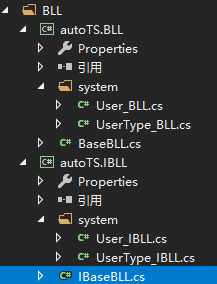
ibll层代码(此层需要引用autoTS.Model)
IBaseBLL.cs
public interface IBaseBLL<TEntity> where TEntity : class
{
#region 1.0 增 void Add(TEntity model); #endregion #region 2.0 删 void Delete(TEntity model, bool isAddedDbContext); #endregion #region 3.0 改 /// <summary>
/// 编辑,约定model 是一个自定义的实体,没有追加到EF容器中的
/// </summary>
/// <param name="model"></param>
void Edit(TEntity model, string[] propertyNames); #endregion #region 4.0 查 /// <summary>
/// 带条件查询
/// </summary>
/// <param name="where"></param>
/// <returns></returns>
List<TEntity> QueryWhere(Expression<Func<TEntity, bool>> where); #endregion #region 5.0 统一保存 /// <summary>
/// 统一将EF容器对象中的所有代理类生成相应的sql语句发给db服务器执行
/// </summary>
/// <returns></returns>
int SaveChanges(); #endregion }
system文件夹下User_IBLL.cs
public interface User_IBLL : IBaseBLL<User>
{
}
bll层中代码(需要引用autoTS.Model、autoTS.IBLL、autoTS.IDAL)
BaseBLL.cs
public class BaseBLL<TEntity> : IBaseBLL<TEntity> where TEntity : class
{
protected IBaseDal<TEntity> dal = null;
#region 1.0 增 public virtual void Add(TEntity model)
{
dal.Add(model);
} #endregion #region 2.0 删 public virtual void Delete(TEntity model, bool isAddedDbContext)
{
dal.Delete(model, isAddedDbContext);
} #endregion #region 3.0 改 /// <summary>
/// 编辑,约定model 是一个自定义的实体,没有追加到EF容器中的
/// </summary>
/// <param name="model"></param>
public virtual void Edit(TEntity model, string[] propertyNames)
{
dal.Edit(model, propertyNames);
} #endregion #region 4.0 查 /// <summary>
/// 带条件查询
/// </summary>
/// <param name="where"></param>
/// <returns></returns>
public virtual List<TEntity> QueryWhere(Expression<Func<TEntity, bool>> where)
{
return dal.QueryWhere(where);
} #endregion #region 5.0 统一保存 /// <summary>
/// 统一将EF容器对象中的所有代理类生成相应的sql语句发给db服务器执行
/// </summary>
/// <returns></returns>
public virtual int SaveChanges()
{
return dal.SaveChanges();
} #endregion }
system文件中User_BLL.cs
public class User_BLL : BaseBLL<User>, User_IBLL
{
User_IDAL dalSer;
public User_BLL(User_IDAL dalSer)
{
base.dal = dalSer;
this.dalSer = dalSer;
}
}
5】公共层all文件夹代码以及结构(圈起来的都是要引用的,前面有红线的则是在nuget中引用 注意引用mvc的版本必须和自己ui层mvc版本一致)
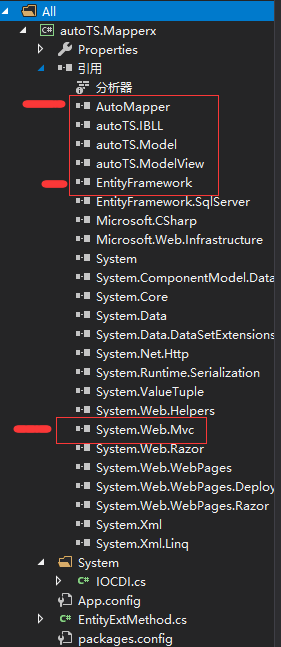
IOCDI.CS
using autoTS.IBLL.system;
using System;
using System.Collections.Generic;
using System.Linq;
using System.Text;
using System.Threading.Tasks;
using System.Web.Mvc; namespace autoTS.Mapperx.System
{
public class IOCDI : Controller
{
protected User_IBLL UserSer;
protected UserType_IBLL UserTypeSer;
}
}
(本次重点)EntityExtMethod.cs中代码是为了实现automapper
using AutoMapper;
using autoTS.Model.System;
using autoTS.ModelView.SystemView;
using System;
using System.Collections.Generic;
using System.Linq;
using System.Text;
using System.Threading.Tasks; namespace autoTS.Mapperx
{
public static class EntityExtMethod
{ #region UserView-User
public static UserView EntityMap(this User model)
{
//利用AutoMapper 来将 User 的属性值动态拷贝到 UserView 类中对应的同名属性值中
// 开始转换
return Mapper.Map<User, UserView>(model);
}
public static User EntityMap(this UserView model)
{
//利用AutoMapper 来将 UserView 的属性值动态拷贝到 User 类中对应的同名属性值中
// 开始转换
return Mapper.Map<UserView, User>(model);
}
#endregion
#region UserTypeView-Type
public static UserTypeView EntityMap(this UserType model)
{
//利用AutoMapper 来将 UserType 的属性值动态拷贝到 UserTypeView 类中对应的同名属性值中
// 开始转换
return Mapper.Map<UserType, UserTypeView>(model);
}
public static UserType EntityMap(this UserTypeView model)
{
//利用AutoMapper 来将 UserTypeView 的属性值动态拷贝到 UserType 类中对应的同名属性
// 开始转换
return Mapper.Map<UserTypeView, UserType>(model);
}
#endregion
}
}
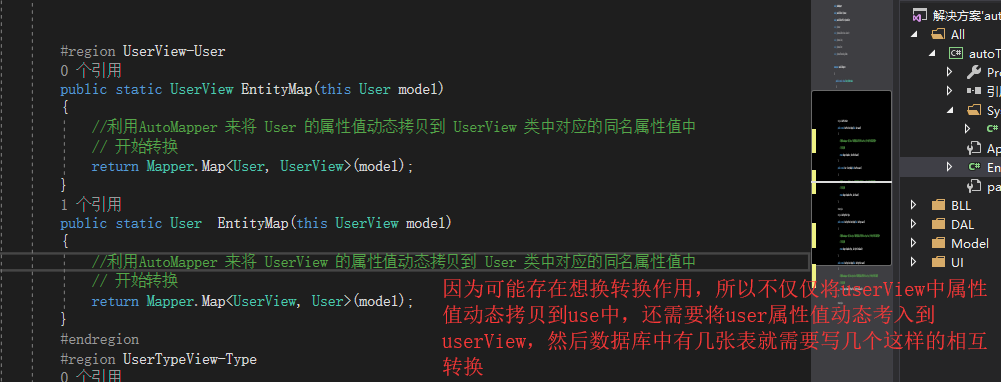
6】最后来到ui层
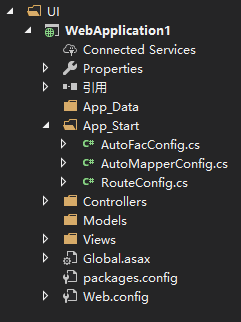
 方框里面是引用部分。而前面带红线的则是需要到nuget中引用(注意第二个autofac.integration.MVC是在nuegt中引用autofac.MVC5得到)
方框里面是引用部分。而前面带红线的则是需要到nuget中引用(注意第二个autofac.integration.MVC是在nuegt中引用autofac.MVC5得到)
首先在app_Start中添加AutoFacConfig.cs(关于这部分内容,之前一份博客已经讲过就不多重复)
using Autofac;
using Autofac.Integration.Mvc;
using System;
using System.Collections.Generic;
using System.Linq;
using System.Reflection;
using System.Web;
using System.Web.Mvc; namespace WebApplication1.App_Start
{
public class AutoFacConfig
{ /// <summary>
/// 负责调用autofac框架实现业务逻辑层和数据仓储层程序集中的类型对象的创建
/// 负责创建MVC控制器类的对象(调用控制器中的有参构造函数),接管DefaultControllerFactory的工作
/// </summary>
public static void Register()
{
//实例化一个autofac的创建容器
var builder = new ContainerBuilder();
//告诉Autofac框架,将来要创建的控制器类存放在哪个程序集 (IOCtsX.UI)
Assembly controllerAss = Assembly.Load("WebApplication1");
builder.RegisterControllers(controllerAss); //告诉autofac框架注册数据仓储层所在程序集中的所有类的对象实例
Assembly respAss = Assembly.Load("autoTS.DAL");
//创建respAss中的所有类的instance以此类的实现接口存储
builder.RegisterTypes(respAss.GetTypes()).AsImplementedInterfaces(); //告诉autofac框架注册业务逻辑层所在程序集中的所有类的对象实例
Assembly serpAss = Assembly.Load("autoTS.BLL");
//创建serAss中的所有类的instance以此类的实现接口存储
builder.RegisterTypes(serpAss.GetTypes()).AsImplementedInterfaces(); //创建一个Autofac的容器
var container = builder.Build();
//将MVC的控制器对象实例 交由autofac来创建
DependencyResolver.SetResolver(new AutofacDependencyResolver(container)); }
}
}
然后再app_Start中添加AutoMapperConfig.cs。这部分一看就是为了实现automapper内容
using AutoMapper;
using autoTS.Model.System;
using autoTS.ModelView.SystemView;
using System;
using System.Collections.Generic;
using System.Linq;
using System.Web; namespace WebApplication1.App_Start
{
public class AutoMapperConfig
{
public static void Initializex()
{
//Entity与DTO的映射 初始化映射的方向 (注册) 写在这里是因为只需要注册一次,
//放在C:\Users\Fates\source\repos\automapperTS\autoTS.Mapperx\EntityExtMethod.cs 中因为每次使用都会注册从而报错(只需要注册一次)
Mapper.Initialize(x =>
{
x.CreateMap<User, UserView>(); //创建User映射到UserView
x.CreateMap<UserView, UserType>(); //反之
x.CreateMap<UserType, UserTypeView>(); //创建UserType映射到UserTypeView
x.CreateMap<UserTypeView, UserType>(); //反之
});
}
}
}
注意自己引用的automapper,高版本和低版本的写法有些不同,如图

如果不知道自己引用的是低版本还是高版本的话,就写Mapper.CreateMap<user, userView>();看是否报错,如果报错则是高版本的automapper,使用左上图写法,否者用右上图写法。
写完这些文件之后去Global.asax中进行注册
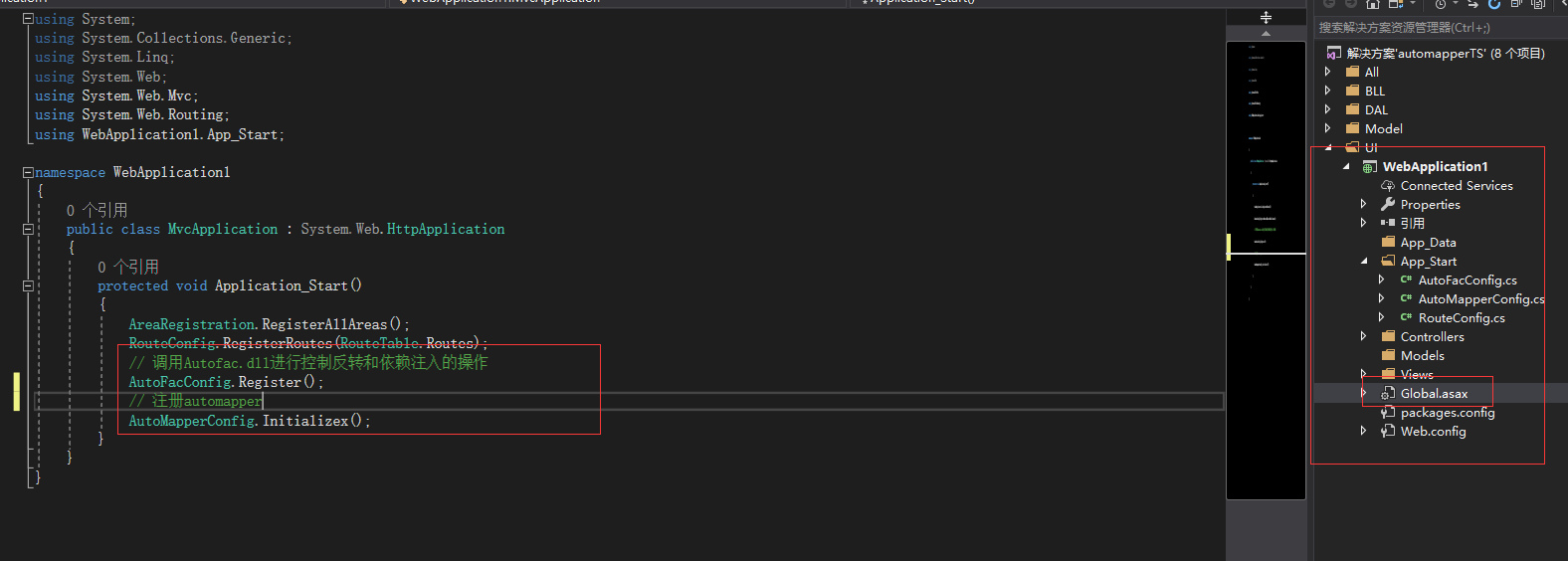
最后,我们来到控制器,写一个demo
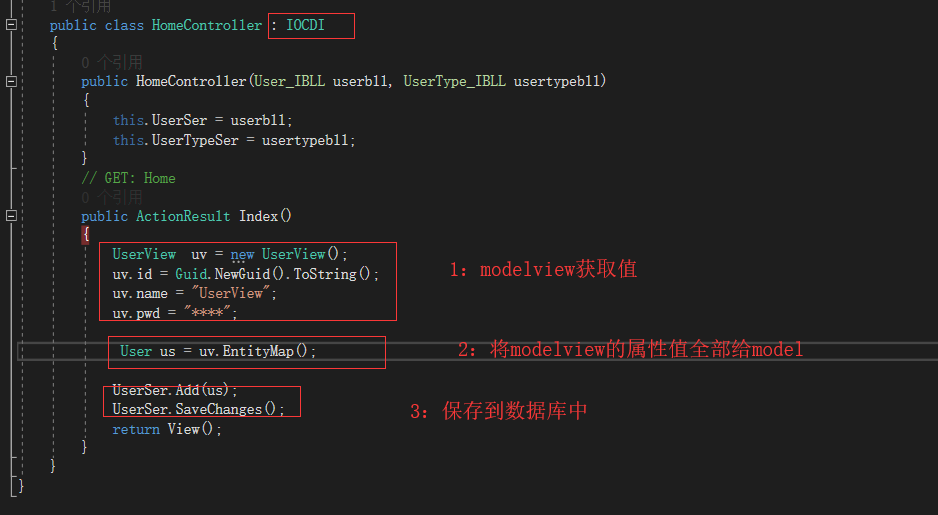
最后来数据库看看结构
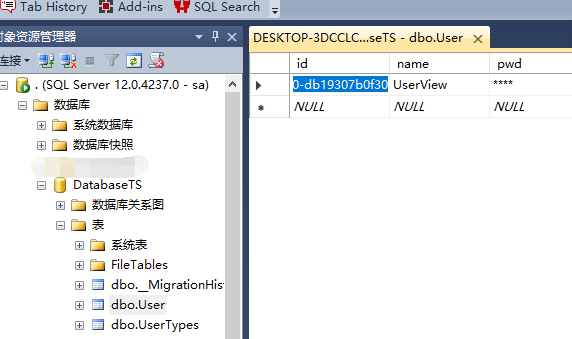
【总结】由于博主技术渣渣,所以文章内容不是太深入。只是简单介绍了如何简单的使用automapper,日后待到这一块深入了解之后,必将更新。此文章适合需要入门automapper的小白,跟着文章一步一步走必将写出一个可运行的demo。因为项目的所有代码和引用文件都已经做了详细的说明。如果懒人党的话,稍后会更新demo下载地址。同时也希望各位大牛的的意见与指点。
ioc初步理解(二) 简单实用autofac搭建mvc三层+automapper=》ioc(codeFirst)的更多相关文章
- ioc初步理解(一) 简单实用autofac搭建mvc三层+ioc(codeFirst)
1]首先搭好框架 1.1]搭建ui层 1.2]创建其他内库文件 整个项目基本部分搭建完毕之后如下 2]使用nuget引用文件 先在每一个项目中引入ef 然后再UI层引入以下两个文件autofac和Au ...
- OC基础--常用类的初步介绍与简单实用之集合类
集合类的异同点 一.NSArray\NSMutableArray *有序 *快速创建(只有不可变数组可以):@[obj1, obj2, obj3]; *快速访问元素:数组名[i] *只能存放对象 二. ...
- C# Ioc容器Unity,简单实用
开头先吐槽一下博客园超级不好用,添加图片后就写不动字了,难道是bug 好进入正题,先来说下依赖注入,简单来说就是定义好接口,上层代码调用接口,具体实现通过配置文件方式去指定具体实现类. 首先我们需要通 ...
- Spring(一):Spring入门程序和IoC初步理解
本文是按照狂神说的教学视频学习的笔记,强力推荐,教学深入浅出一遍就懂!b站搜索狂神说或点击下面链接 https://space.bilibili.com/95256449?spm_id_from=33 ...
- verilog阻塞与非阻塞的初步理解(二)
将阻塞模块改为下述代码: module blocking(clk,a,b,c); :] a; input clk; :] b,c; :] b,c; always @(posedge clk) begi ...
- OC基础--常用类的初步介绍与简单实用之NSString
一.NSString:不可变字符串/NSMutableString:可变字符串 1>字符串的常用创建方式: (1)NSString *s1 = @"Chaos"; (2)NS ...
- 使用Autofac在MVC中实现IOC
var builder = new ContainerBuilder(); //注册DispatchService类型到工厂中 builder.RegisterType<DispatchServ ...
- Spring学习笔记--环境搭建和初步理解IOC
Spring框架是一个轻量级的框架,不依赖容器就能够运行,像重量级的框架EJB框架就必须运行在JBoss等支持EJB的容器中,核心思想是IOC,AOP,Spring能够协同Struts,hiberna ...
- 简单实用的Windows命令(二)
昨天简单的记录了几个非常简单实用的Windows命令,不过我又想起来还有两个我在实际的工作中也是经常用到的命令——PING和IPCONFIG,不过我在工作中的使用都是非常简单的,用PING命令检测对应 ...
随机推荐
- 【爆料】-《南澳大学毕业证书》UniSA一模一样原件
☞南澳大学毕业证书[微/Q:2544033233◆WeChat:CC6669834]UC毕业证书/联系人Alice[查看点击百度快照查看][留信网学历认证&博士&硕士&海归&a ...
- zabbix监控elasticsearch
1.环境概述 虚拟机系统:CentOS Linux release 7.3.1611 (Core) 宿主机系统:Mac Sierra version 10.12.3 nginx:1.10.3 php: ...
- 斯坦福CS224n课程作业
斯坦福CS224n作业一 softmax 作业要求如下: 解析:题目要求我们证明\(softmax\)函数具有常数不变性. 解答:对于\(x+c\)的每一维来说,有如下等式成立: \[softmax( ...
- Kubernetes Ingress Controller的使用及高可用落地
Kubernetes Ingress Controller的使用及高可用落地 看懂本文要具备一下知识点: Service实现原理和会应用 知道反向代理原理,了解nginx和apache的vhost概念 ...
- java数据结构和算法02(栈)
什么叫做栈(Stack)呢?这里的栈和jvm的java栈可不是一个东西... 栈作为一种数据结构,我感觉栈就类似一种接口,实现的话有很多种,比如用数组.集合.链表都可以实现栈的功能,栈最大的特点就是先 ...
- 实现AutoMapper(1.0版本)
最近有个需求就是实体之间自动转换,网上肯定有很多现成的实现,不过还是自己写了一个,就当对java高级特性的一个熟悉的过程.这中间包含了泛型,反射,lamada表达式.对于想了解java高级特性的人来说 ...
- Dubbo Mesh 在闲鱼生产环境中的落地实践
本文作者至简曾在 2018 QCon 上海站以<Service Mesh 的本质.价值和应用探索>为题做了一次分享,其中谈到了 Dubbo Mesh 的整体发展思路是“借力开源.反哺开源” ...
- 欢迎使用IdentityModel文档!- IdentityModel 中文文档(v1.0.0)
IdentityModel是基于声明的身份,OAuth 2.0和OpenID Connect的.NET标准帮助程序库. 它具有以下高级功能: 标准OAuth 2.0和OpenID Connect端点的 ...
- OAuth2.0记录
阮一峰老师讲解OAuth2.0 http://www.ruanyifeng.com/blog/2014/05/oauth_2_0.html 举例详解: https://www.cnblogs.com/ ...
- 将博客搬至CSDN https://blog.csdn.net/Fredric_2014
将博客搬至CSDN https://blog.csdn.net/Fredric_2014
